Abstract
Purified Cryptosporidium parvum oocysts were exposed to ozone, chlorine dioxide, chlorine, and monochloramine. Excystation and mouse infectivity were comparatively evaluated to assess oocyst viability. Ozone and chlorine dioxide more effectively inactivated oocysts than chlorine and monochloramine did. Greater than 90% inactivation as measured by infectivity was achieved by treating oocysts with 1 ppm of ozone (1 mg/liter) for 5 min. Exposure to 1.3 ppm of chlorine dioxide yielded 90% inactivation after 1 h, while 80 ppm of chlorine and 80 ppm of monochloramine required approximately 90 min for 90% inactivation. The data indicate that C. parvum oocysts are 30 times more resistant to ozone and 14 times more resistant to chlorine dioxide than Giardia cysts exposed to these disinfectants under the same conditions. With the possible exception of ozone, the use of disinfectants alone should not be expected to inactivate C. parvum oocysts in drinking water.
Full text
PDF
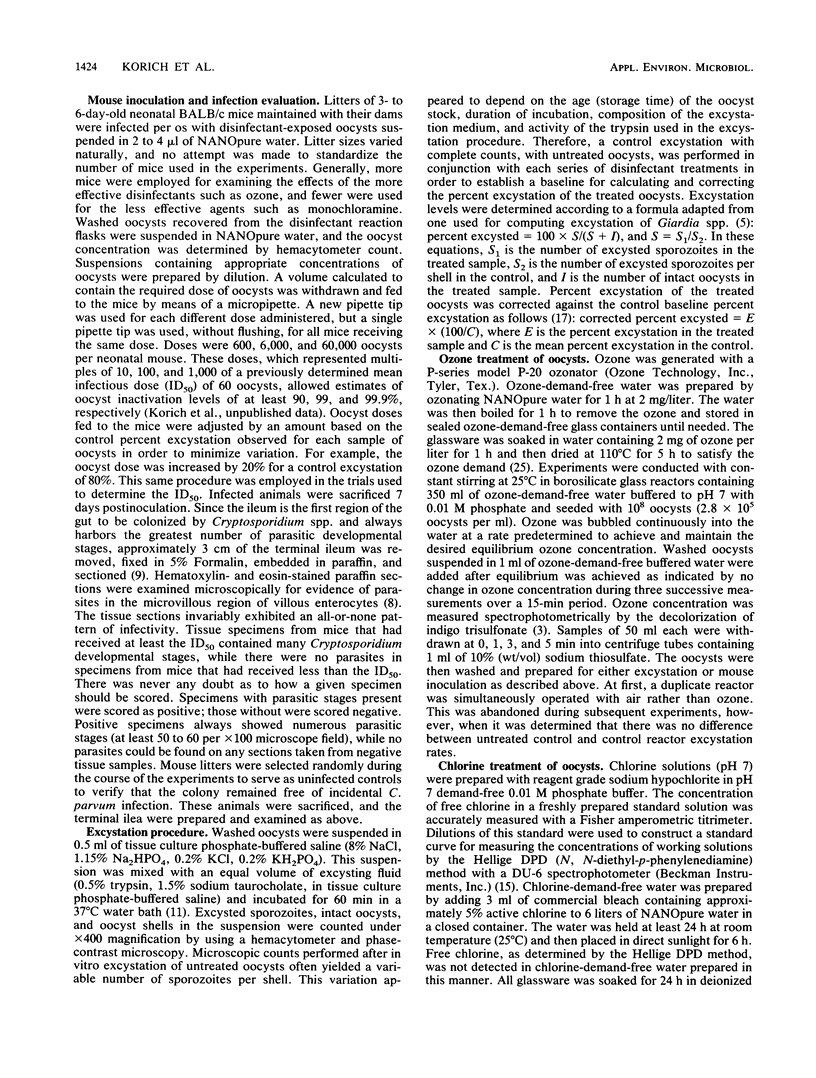
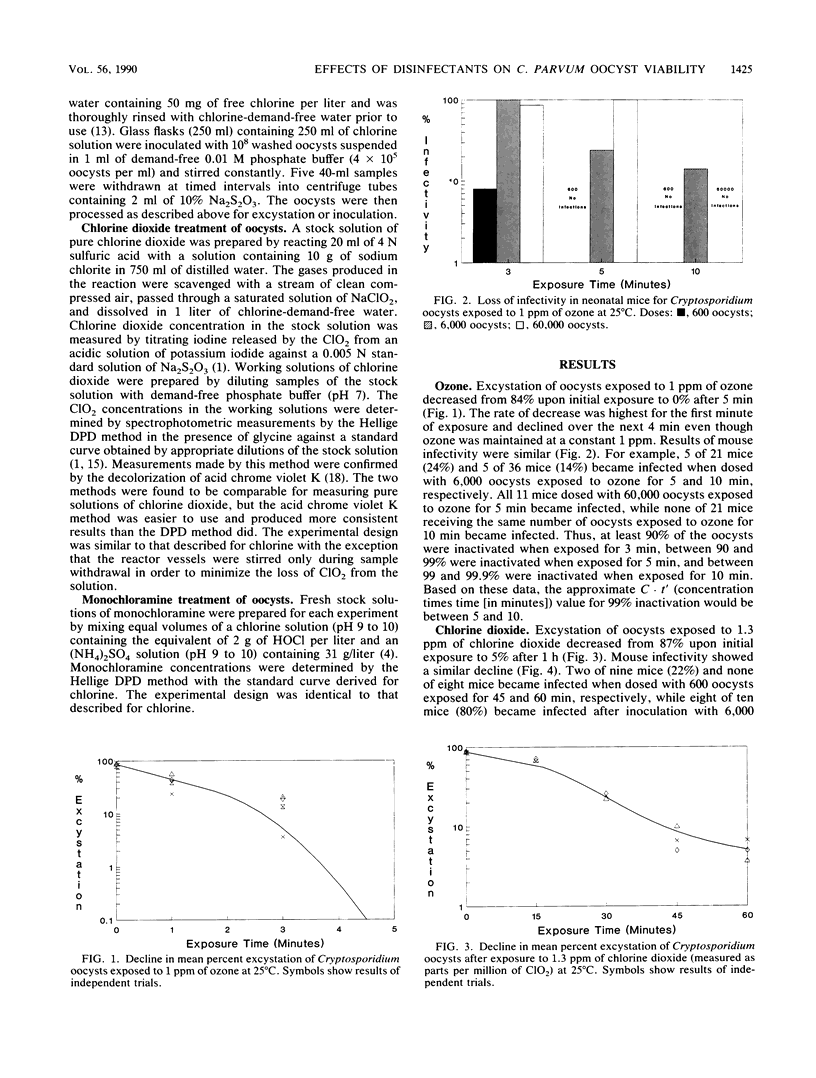
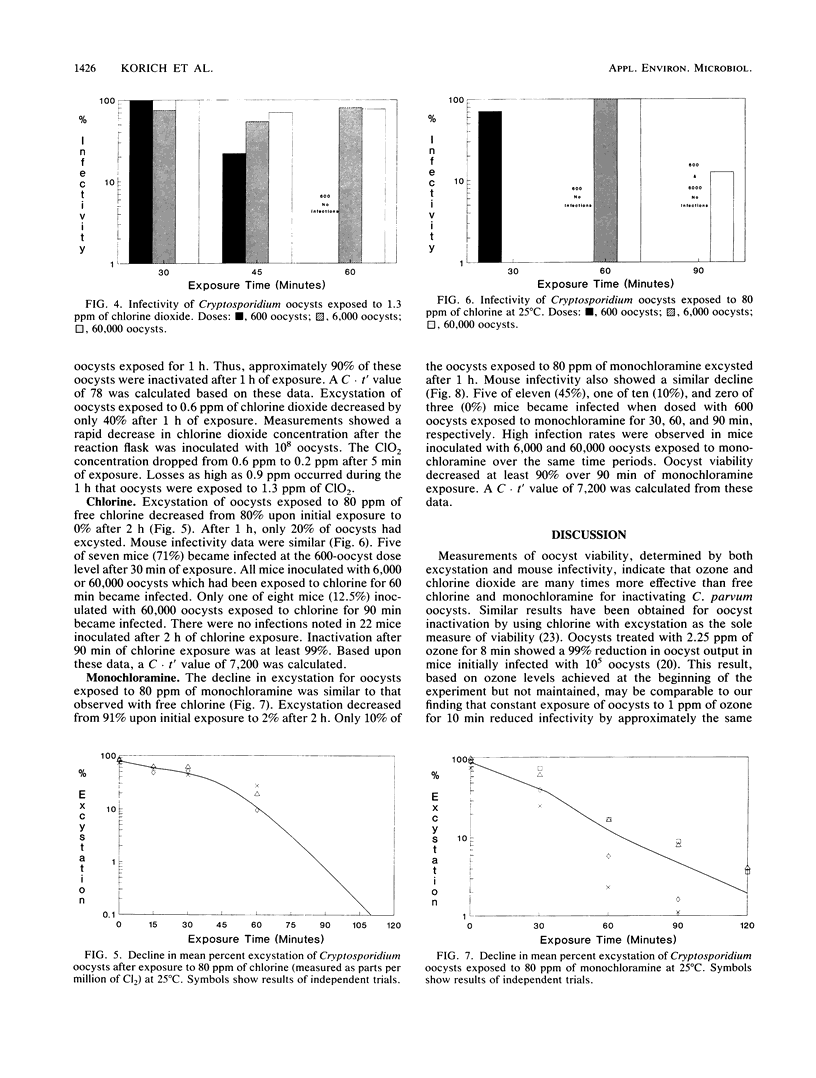
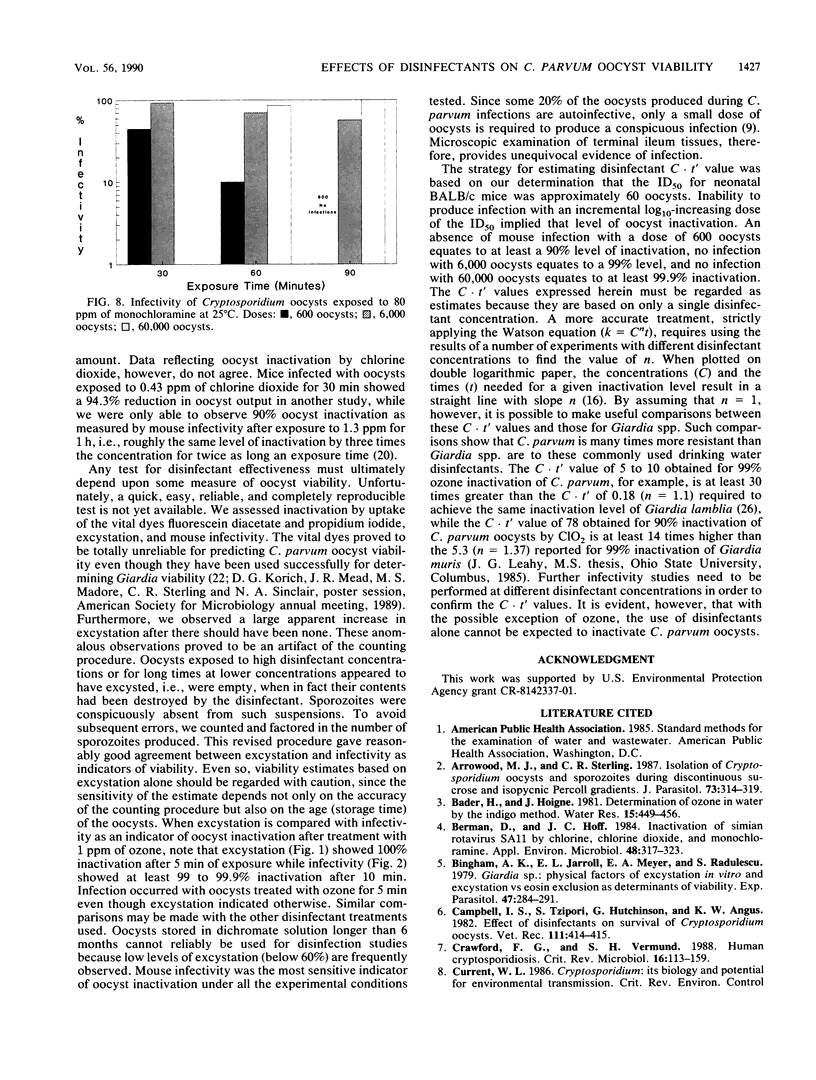
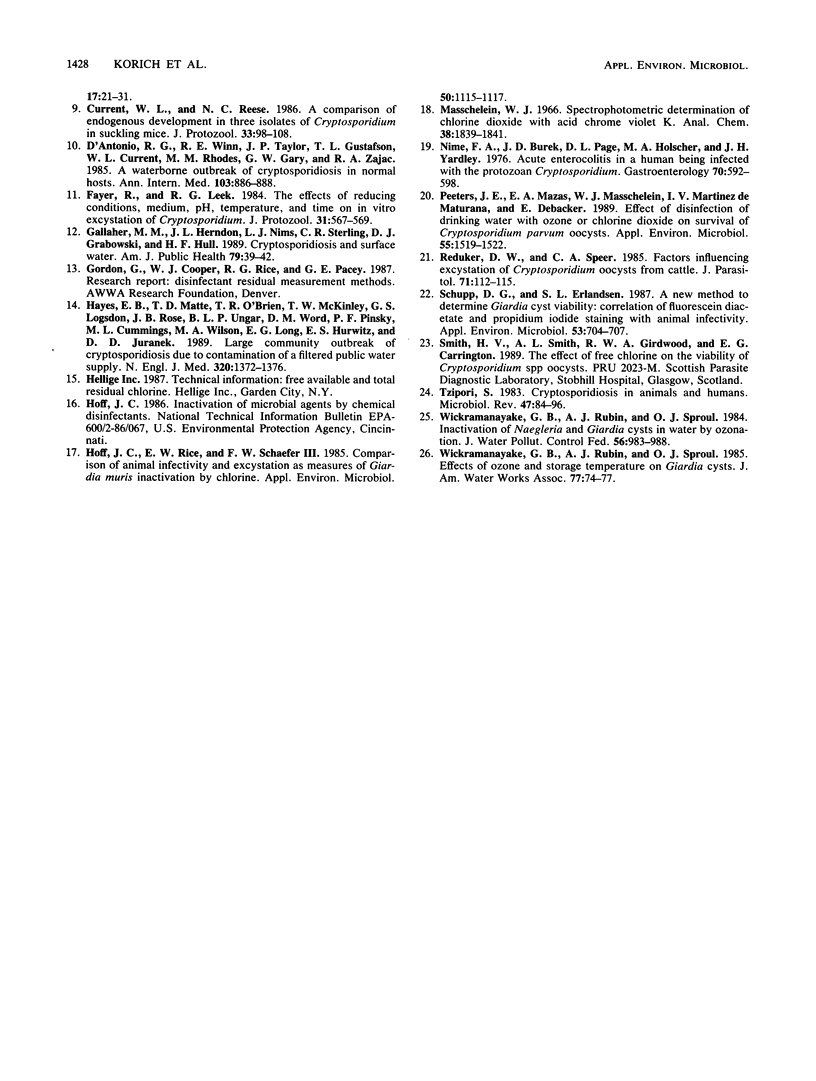
Selected References
These references are in PubMed. This may not be the complete list of references from this article.
- Arrowood M. J., Sterling C. R. Isolation of Cryptosporidium oocysts and sporozoites using discontinuous sucrose and isopycnic Percoll gradients. J Parasitol. 1987 Apr;73(2):314–319. [PubMed] [Google Scholar]
- Berman D., Hoff J. C. Inactivation of simian rotavirus SA11 by chlorine, chlorine dioxide, and monochloramine. Appl Environ Microbiol. 1984 Aug;48(2):317–323. doi: 10.1128/aem.48.2.317-323.1984. [DOI] [PMC free article] [PubMed] [Google Scholar]
- Bingham A. K., Jarroll E. L., Jr, Meyer E. A., Radulescu S. Giardia sp.: physical factors of excystation in vitro, and excystation vs eosin exclusion as determinants of viability. Exp Parasitol. 1979 Apr;47(2):284–291. doi: 10.1016/0014-4894(79)90080-8. [DOI] [PubMed] [Google Scholar]
- Campbell I., Tzipori A. S., Hutchison G., Angus K. W. Effect of disinfectants on survival of cryptosporidium oocysts. Vet Rec. 1982 Oct 30;111(18):414–415. doi: 10.1136/vr.111.18.414. [DOI] [PubMed] [Google Scholar]
- Crawford F. G., Vermund S. H. Human cryptosporidiosis. Crit Rev Microbiol. 1988;16(2):113–159. doi: 10.3109/10408418809104469. [DOI] [PubMed] [Google Scholar]
- Current W. L., Reese N. C. A comparison of endogenous development of three isolates of Cryptosporidium in suckling mice. J Protozool. 1986 Feb;33(1):98–108. doi: 10.1111/j.1550-7408.1986.tb05567.x. [DOI] [PubMed] [Google Scholar]
- D'Antonio R. G., Winn R. E., Taylor J. P., Gustafson T. L., Current W. L., Rhodes M. M., Gary G. W., Jr, Zajac R. A. A waterborne outbreak of cryptosporidiosis in normal hosts. Ann Intern Med. 1985 Dec;103(6 ):886–888. doi: 10.7326/0003-4819-103-6-886. [DOI] [PubMed] [Google Scholar]
- Fayer R., Leek R. G. The effects of reducing conditions, medium, pH, temperature, and time on in vitro excystation of Cryptosporidium. J Protozool. 1984 Nov;31(4):567–569. doi: 10.1111/j.1550-7408.1984.tb05504.x. [DOI] [PubMed] [Google Scholar]
- Gallaher M. M., Herndon J. L., Nims L. J., Sterling C. R., Grabowski D. J., Hull H. F. Cryptosporidiosis and surface water. Am J Public Health. 1989 Jan;79(1):39–42. doi: 10.2105/ajph.79.1.39. [DOI] [PMC free article] [PubMed] [Google Scholar]
- Hayes E. B., Matte T. D., O'Brien T. R., McKinley T. W., Logsdon G. S., Rose J. B., Ungar B. L., Word D. M., Pinsky P. F., Cummings M. L. Large community outbreak of cryptosporidiosis due to contamination of a filtered public water supply. N Engl J Med. 1989 May 25;320(21):1372–1376. doi: 10.1056/NEJM198905253202103. [DOI] [PubMed] [Google Scholar]
- Hoff J. C., Rice E. W., Schaefer F. W., 3rd Comparison of animal infectivity and excystation as measures of Giardia muris cyst inactivation by chlorine. Appl Environ Microbiol. 1985 Oct;50(4):1115–1117. doi: 10.1128/aem.50.4.1115-1117.1985. [DOI] [PMC free article] [PubMed] [Google Scholar]
- Nime F. A., Burek J. D., Page D. L., Holscher M. A., Yardley J. H. Acute enterocolitis in a human being infected with the protozoan Cryptosporidium. Gastroenterology. 1976 Apr;70(4):592–598. [PubMed] [Google Scholar]
- Peeters J. E., Mazás E. A., Masschelein W. J., Villacorta Martiez de Maturana I., Debacker E. Effect of disinfection of drinking water with ozone or chlorine dioxide on survival of Cryptosporidium parvum oocysts. Appl Environ Microbiol. 1989 Jun;55(6):1519–1522. doi: 10.1128/aem.55.6.1519-1522.1989. [DOI] [PMC free article] [PubMed] [Google Scholar]
- Reduker D. W., Speer C. A. Factors influencing excystation in Cryptosporidium oocysts from cattle. J Parasitol. 1985 Feb;71(1):112–115. [PubMed] [Google Scholar]
- Schupp D. G., Erlandsen S. L. A new method to determine Giardia cyst viability: correlation of fluorescein diacetate and propidium iodide staining with animal infectivity. Appl Environ Microbiol. 1987 Apr;53(4):704–707. doi: 10.1128/aem.53.4.704-707.1987. [DOI] [PMC free article] [PubMed] [Google Scholar]
- Tzipori S. Cryptosporidiosis in animals and humans. Microbiol Rev. 1983 Mar;47(1):84–96. doi: 10.1128/mr.47.1.84-96.1983. [DOI] [PMC free article] [PubMed] [Google Scholar]


